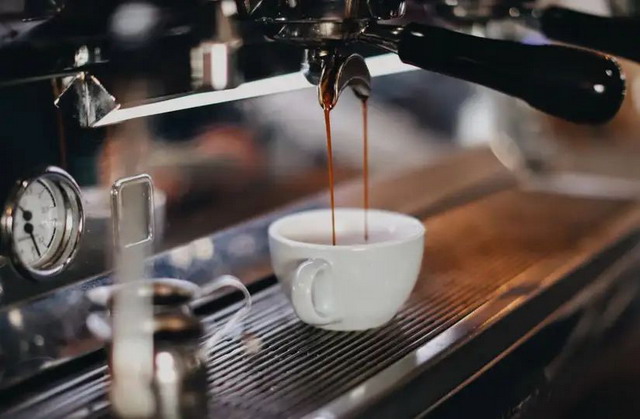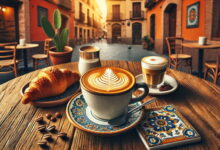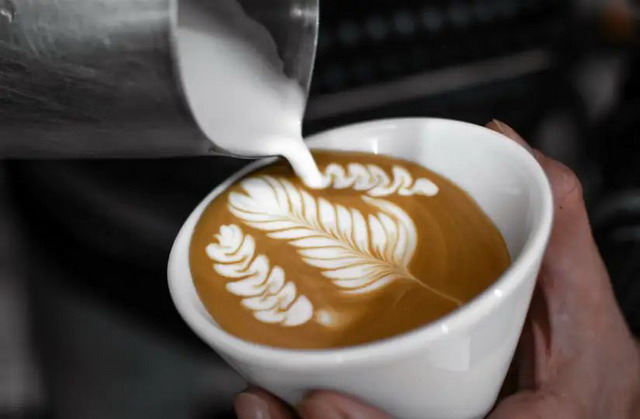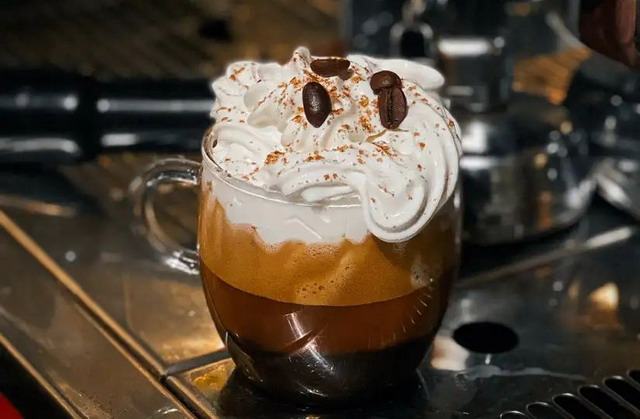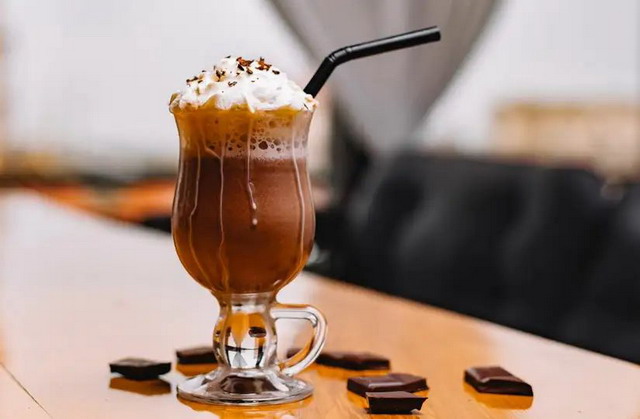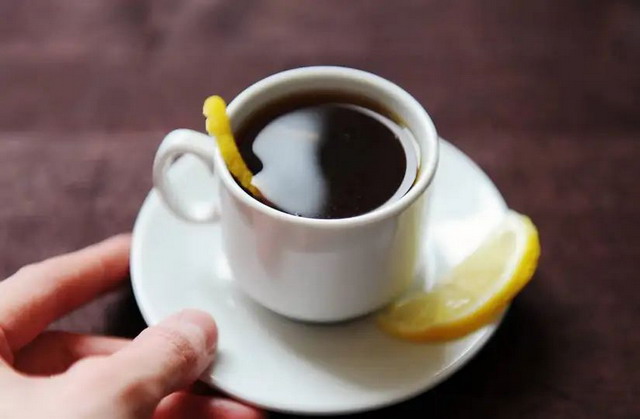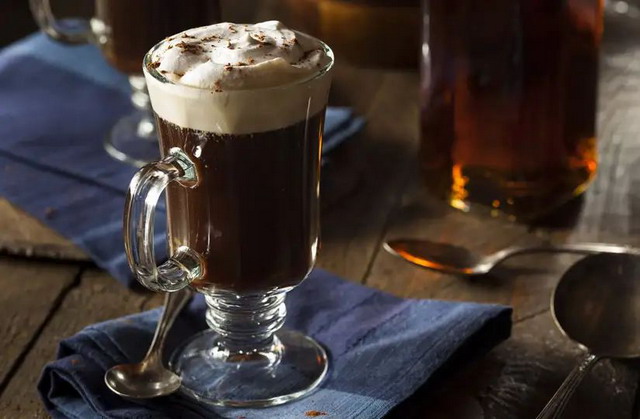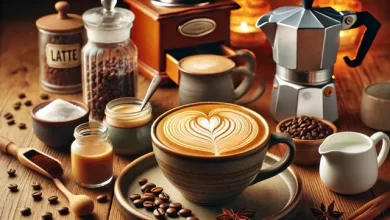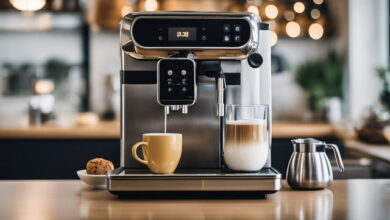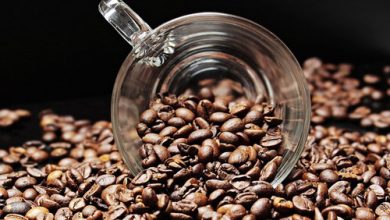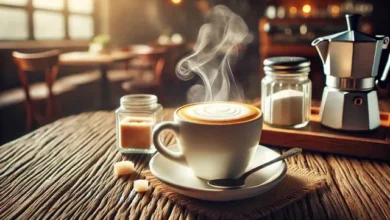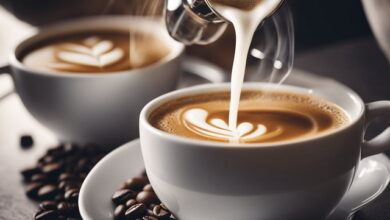Types of Coffee in Coffee Shops: A Complete Guide to Classic and Trendy Drinks with Recipes
Types of Coffee in Coffee Shops
For several centuries, people have been figuring out how best to make coffee and what to mix it with to make it delicious. As a result, we have a huge selection of classic and original coffee drink recipes. Many of which you can learn to make at home.
Coffee and water – nothing extra
“Just coffee” – this phrase can be used to describe all drinks based on the most common espresso (and, in fact, espresso itself). Let’s start with it.
Espresso
A basic drink, complex and simple at the same time. Not everyone can make a really tasty espresso, because everything matters: the quality of the beans, the roast, the size of the grind, the hardness of the water, the settings of the coffee machine. In short, espresso is a delicate matter.
The modern approach involves the barista preparing a double shot of espresso using 18g of beans, then using either all or half of it, depending on the volume of the drink.
The principle of making espresso
Water is passed under high pressure through ground beans for 25–30 seconds. The result should be 36–40 g of rich and moderately strong coffee, in which acidity, bitterness and sweetness are balanced. This double shot is considered the basis for the rest of the coffee variety. As an independent drink, espresso (single, 18–20 g) is traditionally served in small demitasse cups.
Don’t be confused by the fact that all measurements are in grams: baristas do not measure coffee drinks and their ingredients in milliliters because they work with units of weight.
Doppio and triplo
That same double, as well as triple portion of espresso, that’s all. Suitable for lovers of a large cup who do not want to sacrifice richness. Ideal when you urgently need to wake up or perk up. The output of drinks, respectively, is 36-40 g (a regular double shot) or 72-80 g.
Ristretto
Translated from Italian, it means “short” coffee, which has less water than espresso. This “thimble” is prepared using the same 18 g of beans, but for 15–20 seconds instead of 25–30. And it is always served with a glass of water to refresh the taste buds. But desserts or sugar are considered bad form in the case of ristretto. The drink has increased acidity and a very dense body, but it has much less caffeine than espresso. It has a long aftertaste. The yield from 18 g of beans is 14–16 g of ready-made coffee.
Lungo
Another variation on the espresso theme. Lungo is the opposite of ristretto and is translated from Italian as “long”: from a standard portion of beans weighing 18 g, about 40-60 g of the drink is prepared. The size of the grind is very important: the coarser it is, the faster the water passes through it. For lungo, a larger fraction of the beans is taken and more water is poured through it than when preparing espresso. As a result, more caffeine is released into the water, but the drink turns out to be somewhat watery, with a light body and a short aftertaste.
Since lungo requires a coarser grind than espresso, coffee shops that serve this drink always have an additional grinder set specifically for it.
Americano
Water plus espresso. Or espresso plus water, depending on the method. In the Swedish version, it is customary to first prepare the espresso and then dilute it with water. In Italy, they do it the other way around: first pour hot water into the cup, and then extract the espresso directly into it. This allows the crema to remain on the surface of the drink, which gives it a more noble appearance. The amount of water can vary, but the classic is 120 g per single shot.
Americano is good for those who like not too strong coffee in a large mug: you can stretch it out for a long time, washing it down with dessert and not rushing anywhere, because the volume of the drink is about 160 ml or even more. We wrote more about Americano in this article .
In Australia, the Swedish method has its own name – long black. Its characteristic feature is a double portion size by default.
Coffee drinks based on espresso and milk
At first, milk and cream were added to coffee to soften its bitter taste. And then baristas got going and started experimenting with different types of milk and its plant-based analogues. That’s why today we have so many variations of coffee with milk. And the main thing when preparing them is to keep the proportions.
Cappuccino (1:4)
The most popular coffee drink in the world. It dates back to the 19th century, but it was only in the 20th century that the recipe was finally established: for a single shot of espresso, there are four equal portions of warm, strongly whipped milk (i.e. about 70–80 g), which are poured on top. The result is the most harmonious combination of milk and coffee flavors. The drink always has a natural sweetness, and the foam is about 1.5 cm thick.
Latte (1:6)
An option for lovers of milk and special tenderness, in which coffee is related to the milk part in a proportion of 1:6. Latte is considered a dessert drink, light, almost for children. As for cappuccino, milk is warmed and whipped, and then poured in a thin stream into a shot of espresso. The recommended level of foam is about 0.5–1 cm.
By the way, if you don’t have a cappuccino maker, you can froth milk for latte and cappuccino using a French press.
Espressino (1:1)
A rare hybrid in our latitudes, but popular in Italy, of espresso and cappuccino. This coffee drink with the addition of milk foam was invented in the southern region of Apulia. Unlike regular cappuccino, it is served in a small demitasse cup, since there is only one part of foamed milk per shot of espresso.
Espressino also has a variation where it is prepared with a double shot and, accordingly, the amount of milk is doubled – this is a cortado.
Piccolo (1:2)
An Australian version of cappuccino, translated from Italian means “small”. The ratio of espresso to milk base is 1:2, that is, for one shot you need to take two parts of milk. The drink turns out very smooth and airy, but small in volume.
Macchiato (1:0.2)
Literally from Italian – “stained”. This is a portion of espresso, into which a teaspoon of milk is carefully poured. It leaves a beautiful white spot on the surface of the cream. Outside Italy, a 1:1 mixture of coffee and milk is often offered under the guise of macchiato, but this cannot be called canon.
Latte macchiato (1:6)
While a regular latte is made by adding milk to a half shot of espresso, a latte macchiato is the opposite: espresso is poured into the milk from a holder, leaving a dark spot on a white background. The ratio of milk to espresso is usually kept at 1:6.
Is a flat white a latte, a cappuccino or a standalone drink?
Flat white (1:3)
This version of coffee with milk was invented by Australians. It is based on three portions of milk per espresso, which is hardly whipped. Flat white is translated from English as “flat white”, so the foam, as the name suggests, should be flat – no more than 0.5 mm.
Although we are talking about reference recipes here, in practice they vary greatly from coffee shop to coffee shop. It depends on many factors, from the type of roast to the volume of the cup or glass.
Types of coffee with cream
Con panna
One of the oldest coffee drinks, invented long before cappuccino. It is prepared very simply: a single or double shot of espresso is covered with a cap of sweet whipped cream. You can additionally decorate the top with cinnamon, grated chocolate, ground nuts or thin orange shavings. In Italy, this drink is called vesuviano.
Melange
Traditionally prepared in Viennese coffee houses, hence its second name – Viennese coffee. Very similar to the previous version, but it does not necessarily have to be based on espresso, any black coffee can be added. The drink first appeared on the menu at the end of the 19th century and was coffee brewed in a cezve with spices and honey, to which whipped milk was then added.
In addition to the classic, there is also the so-called imperial melange (Kaisermelange), to which cognac, honey and egg yolk are added.
Torre
Another relative of latte, which is characterized by a distinct separation into two layers – coffee and milk foam. The foam should be well whipped and not lie flat in the glass, but rise above it like a cap, explaining the name of the drink: “torre” is translated from Italian as “tower”. The barista puts the foam with a spoon so that it does not mix with the coffee. The proportions are the same as for latte – 1:6.
Breve
A small coffee drink invented in the USA. It has clear proportions: a single shot of espresso contains 18 g of warm milk and the same amount of cream. All ingredients are mixed until smooth. Sugar can be omitted: lactose provides enough sweetness.
Coffee drinks with added chocolate and cocoa
Mocha (or mocha)
An American variety of latte with added chocolate. You can use either melted solid chocolate or chocolate syrup, or cocoa powder. Although the mocha recipe varies from establishment to establishment, according to the canon, it should contain a single shot of espresso and a glass of milk (200 ml). The rest is cream, chocolate, foam.
Bicherin
Or “Turin coffee”. The national drink of the inhabitants of Piedmont, a northern region of Italy. It is prepared on the basis of espresso with the addition of dark chocolate and whipped cream, and served in a glass. For this recipe, the barista places 50 g of melted dark chocolate at the bottom of the glass, then pours in espresso, and covers it with a cap of whipped cream on top. The drink can be garnished with grated chocolate or a mint leaf.
Marocino
If you mix a shot of espresso and a teaspoon of dry cocoa in a cup, and then garnish it with milk foam (30–35 g), you will get another favorite drink of the Piedmontese.
Borgia
An invigorating sweet drink that charges you with energy for a long time. According to the traditional recipe, the barista should mix a double espresso and hot chocolate in a 1:1 ratio in one cup, and then decorate this caffeine bomb with a cap of cream. In fact, everyone experiments with the proportions and methods of adding chocolate as they wish. Sometimes, pieces of chocolate are simply placed on the bottom of the cup, where coffee is then poured. Just like in a bicerina.
Types of drinks based on coffee and unexpected ingredients
Romano
It is also called espresso romano (espresso in Roman style). Invented in Italy, it is prepared on the basis of the same cup of espresso. A teaspoon of lemon juice and a piece of thinly sliced lemon zest are added to the coffee for beauty. It is quite an acidic and very refreshing drink, ideal for a hot summer day.
If you use lime instead of lemon, you get Spanish coffee guillermo.
Masala
The famous Indian coffee, prepared with the spice mixture of the same name. In the original version, it is simply boiled in milk instead of water. However, variations are possible: for example, 50% water and 50% milk. The drink is considered warming, almost medicinal. Among the spices used for masala are star anise, cloves, cinnamon, nutmeg, cardamom, etc. The proportions are the same as for a Turk: 10 g of beans – 100 ml of liquid.
Kishr
Another spicy coffee, but this time from Yemen. Africans mix ground beans (3 tsp) and dry ginger (1.5 tsp), pour a glass of water and brew in a 200 ml Turk. It is believed that such coffee promotes digestion.
“Bulletproof”
An invention by American Dave Asprey. After traveling to Tibet, where the inhabitants warm themselves with tea with butter, he decided to try to create the same satiating coffee. Asprey called the resulting drink of strong coffee with the addition of butter and coconut oil Bulletproof and declared it a real find for those who want to quickly and powerfully increase their mental abilities. It’s hard to say anything about the latter, but a cup of nutritious drink can really replace a whole breakfast. To prepare Bulletproof, mix 200 ml of black coffee, a teaspoon of melted butter and the same amount of coconut oil in a cup using a whisk.
“Red Eye”
“Red Eye” is for those who need to quickly perk up after a sleepless night. Historically, it was drunk by representatives of New York bohemia to get themselves in order after night parties in clubs, students during exam sessions and truck drivers to stay awake at the wheel. The drink has many variations, differing only in the strength and amount of caffeine per cup, but the basic principle of preparation is as follows: two servings of espresso per 120 ml of filter coffee. The taste is not particularly important, because it is not drunk to enjoy the fruity sourness. The drink is not recommended for people with cardiovascular and nervous system diseases.
Yuanyang (so-called dirty coffee)
An unexpected mixture of tea and coffee originates from Asia. It is prepared with many variations depending on the region. For example, in China and Hong Kong they make a mix of a shot of espresso and strong black tea in a 1:2 ratio with the addition of condensed milk as a sweetener. In Africa, regular coffee from a cezve is mixed with tea in a 1:1 ratio and sugar is added to the drink. Europeans experiment with the recipe, using different types of milk.
Nocciola
An Italian coffee with a nutty flavor, a favorite delicacy of the Neapolitans. To prepare nocciola according to the traditional recipe, the barista puts nut cream or nut paste on the bottom of a small glass, places a second layer of coffee mousse, and pours a shot of espresso on top.
Cold coffee drinks
Almost all of these recipes originated in countries with warm climates: the hotter the weather, the stronger the need to drink cooling drinks. And this is not a reason to give up coffee!
Mazagran
This is the world’s first cold coffee, invented in Algeria in the 19th century, during the siege of the fortress of Mazagran. According to legend, the French, tired of the heat, besieged in the fortress, began to dilute the coffee with cold water and flavor it with lemon juice. Today, the canonical recipe for Mazagran is similar to the recipe for Romano coffee, only chilled: a shot of espresso, a spoonful of lemon juice and lots of ice. Of course, you can add syrup if desired.
Espresso tonic
This is, on the contrary, the most modern of cold coffee drinks. It is prepared on the basis of espresso with ice and tonic. To get a canonical espresso-tonic, you need to fill a large glass (350 ml) with ice to the very top, pour in 150 ml of tonic, and then a double espresso. Served with a straw, sometimes garnished with a mint leaf.
Ice coffee
Good old iced coffee, suitable for both a tropical resort and summer Moscow. There are about as many recipes as there are people who make this drink, but the basic ingredients are always the same: chilled coffee, prepared in any way, sweetener and crushed ice. Additionally, iced coffee can contain milk, condensed milk, whipped cream, orange juice, etc.
Con Yelo
A Spanish variety of iced coffee. It has distinctive features: firstly, it never contains dairy additives, and secondly, the ice is served separately from the hot coffee. It is assumed that you first add sugar (and it dissolves easily and quickly), and only then pour the sweetened drink into a glass with large ice cubes.
Fredo
An Italian fantasy on the theme of iced coffee. The name translates as “very cold” or “the coldest”. In the classic version, it is prepared from two portions of espresso, 70 g of milk, syrup and crushed ice. It is customary to serve this coffee by shaking it in a shaker and drinking it very slowly, through a straw.
Glace
A well-known drink with a scoop of ice cream. However, just coffee with ice cream is not considered a glacé: first, you need to cool the Americano to 10 degrees and only then add the scoop of cream. Although there are no strict proportions, recommendations for baristas usually say that the volume of ice cream should be about 25% of the volume of coffee. In fact, this looks like a standard serving of Americano and a fifty-gram scoop of ice cream.
Affogato
Translated from Italian, it means “drowned”. Another drink, but in fact it is already a dessert, since the proportions are 1:1. A scoop of vanilla ice cream (50 g) is poured with a cup of espresso. The resulting treat is not drunk, but eaten with a spoon. Affogato is served in a cold bowl so that the ice cream does not melt longer even when combined with hot coffee.
Frappe
One of the few coffee drinks that is traditionally made from instant coffee. It was invented in Greece, at the 1957 Thessaloniki International Trade Fair. When there was no cooler with hot water, Nestlé employee Dimitrios Vakondios mixed instant coffee with cold water and sugar and shook them in a shaker. The inexpensive and simple drink gained incredible popularity, and Greek bartenders “enhanced” it with crushed ice, turning it into a real non-alcoholic cocktail. The proportions for a classic frappe of medium sweetness: 2 tsp. instant coffee, 50 ml of water, 2 tsp. sugar, crushed ice and 100 ml of milk. All ingredients are shaken in a shaker. The drink is served with a straw and a long spoon.
Dalgona
It is also known as “quarantine coffee”, invented in Korea during the Covid-isolation era. To prepare it, you need to whip up foam from three ingredients: take two tablespoons of instant coffee, water and sugar. Then dilute the resulting thick foam with a glass of milk. If desired, you can add ice to the milk.
Bombon
The name of this coffee drink is translated from Spanish as “candy” and largely reflects its essence: a double shot of espresso in a bombone requires the same amount of condensed milk, that is, about 36 g. The condensed milk is beautifully laid out as the first layer, then coffee is carefully poured in, and crushed ice is placed on top. The drink is served in a glass.
Cold brew
Coffee prepared using the cold extraction method: 100-150 g of ground beans are poured with a liter of water and put into the refrigerator for 12 hours or even a day. During this time, the coffee gives all its properties to the water, and the result is a drink saturated with caffeine and essential oils, but at the same time quite light and fresh, without bitterness or bright sourness.
*Warning: The material contains references to products that may be harmful to your health.
Coffee drinks with added alcohol
Irish from Ireland
It is also known as Irish coffee. Bright, sweet and tasty Irish was invented by a bartender in Foynes to warm up passengers on a plane that had made an emergency landing due to bad weather. In addition to coffee, sugar and whipped cream, the drink also included a “secret” ingredient – Irish whiskey. The classic recipe calls for 80 g of black coffee, 40 g of whiskey, a teaspoon of cane sugar and a cap of whipped cream.
Corretto from Spain
An Italian coffee drink based on a single espresso with a small amount of strong alcohol added – grappa, sambuca or brandy (10-15 g). In Spain, the same cocktail is called carajillo and is flavored with brandy, rum or aniseed vodka.
Moretta from Italy
Or moretta fano – an invention of sailors and workers of the port of Fano. On cold days, sailors warmed themselves by pouring liqueur or brandy heated with spices and sugar and a shot of strong espresso into a cup. The “cultured” version of moretta is served in a heated glass, and the drink itself consists of layers: liqueur at the bottom, then coffee, and coffee foam on top. The amount of liqueur varies.
Brulot from France
The national drink of the Creoles, descendants of immigrants from France who settled in the southern United States. In addition to coffee, it contains a mixture of spices (cloves, cinnamon, lemon and orange zest), cane sugar and brandy. The latter can be replaced with cognac. First, you need to heat the brandy with spices and sugar (until it completely dissolves), then set fire to the mixture so that it caramelizes, and only then carefully pour in the finished coffee. Brulo is considered a sociable drink and is ideal for a fun party.

